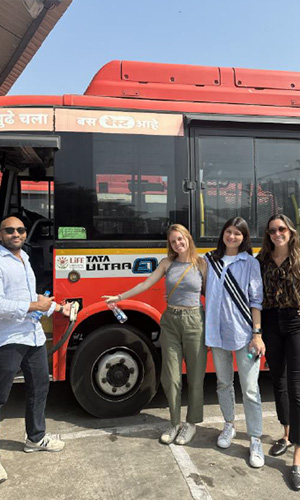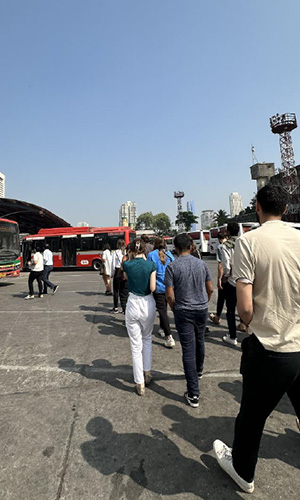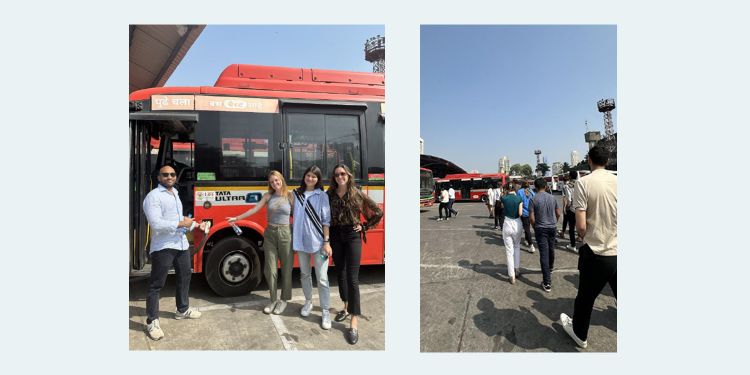Professor Vikram Gandhi’s Immersive Field Course (IFC) “Development while Decarbonizing: India’s Path to Net-Zero" delved into the critical aspect of decarbonization and sustainability goals amid India's rapid development. The course presented an opportunity for students to advance their knowledge of sustainability efforts, decarbonization, and net zero in the context of a broader development agenda. The class culminated in a series of site visits in January 2024 in Mumbai and Bangalore and this is one of 14 student essays that highlights their reflections on uncovering sustainable solutions across the country.
Our recent field trip to India provided valuable insights into the challenges and opportunities associated with decarbonization, particularly focusing on the financing aspects. Based on a discussion with India Climate Collaborative, we outlined four challenges that the country faces in its journey towards a net-zero target by 2070:
1) Funding Gap – Where is the Money Coming From?
A study by the CEEW (Singh & Sidhu, 2021) reveals that India needs USD 10.1 trillion between 2020 and 2070 to achieve its net-zero target. Conventional sources of capital are expected to provide USD 6.6 trillion, leaving a substantial investment gap of USD 3.5 trillion. To bridge this gap, India requires investment support worth USD 1.4 trillion until 2070, with an annual average of USD 28 billion over the next 50 years. Key sectors such as electricity, hydrogen, and vehicles are the focus of this estimate, presenting a roadmap for sustainable investment.
Is this gap unsurmountable? We believe there are reasons to feel hopeful - It all depends on how we choose to contextualize. Benchmarking the funding gap against average income per capita in rich countries (USD 40 thousand per year) offers optimism. If individuals in rich countries contribute USD 700 each, we could potentially meet the funding needs.
2) Where is the Current Funding Going?
80% of the allocated funds are directed towards energy and mobility, accounting for 40% of emissions. Sectors such as agriculture, food systems, industry, steel, and cement, collectively responsible for 60% of emissions, are not receiving adequate funding. Notably, two-thirds of venture capital (VC) is channeled into electric vehicles (EVs), indicating a disproportionate focus.
3) Global North and Global South Disparities
Despite the potential for higher social returns in developing countries, 80% of climate finance still flows to developed nations. The pivotal moment for India lies in the current decisions shaping whether it follows a high or low carbon pathway.
4) Adaptation vs. Mitigation
Only 10% of the allocated funds are dedicated to adaptation efforts, highlighting the need for a more balanced approach. Striking a balance between mitigation and adaptation is crucial for addressing the immediate impacts of climate change.
Learning from Site Visits

After spending extensive time researching our sites, our team was very excited to visit them in person in Mumbai! We attended sessions at the famous Bombay Gymkhana club in Mumbai. We had impressive guests from each site that gave tremendous overviews on GEAPP and BEST. After the presentations, our team led a site visit in person at BEST.
GEAPP Field Visit
Overview: GEAPP is an alliance of entrepreneurs, governments, technology, policy, and financing partners working together to support developing countries shift to a clean energy model that ensures universal energy access while enabling the global community to meet critical climate goals during the next decade. It was founded by Rockefeller and Ikea foundations and the Bezos Earth Fund. GEAPP launched at COP26 with aligned investments of $10B+. It is an alliance of preeminent philanthropic, government, donor, multilateral development banks, development finance institutions and private sector partners working to improve people’s lives through an inclusive and just transition to renewable energy for all. It is made up of anchor partners, investment partners, and delivery partners, as well as the country partners we work with.
Key Objectives:
a. Help avoid or avert over 4 billion tons of greenhouse gasses
b. Extend sustainable, reliable, productive-use energy to 1 billion underserved people
c. Enable 150 million green jobs that generate inclusive economic growth
Takeaways:
• Coordination Challenges: GEAPP recognizes that the primary challenge lies in coordinating diverse stakeholders to reach a tipping point in the renewable energy sector. Convincing the government, despite being a crucial leader, proves to be a significant hurdle. Overcoming this challenge is essential for effective sectoral leadership.
• Blended Finance Criticism: There's a notable criticism of blended finance, particularly using philanthropic capital to de-risk private investments. The response emphasizes investing philanthropic funds in systemic changes, acknowledging the pragmatic but imperfect nature of this approach for ecosystem building.
• FDI Incentives: To encourage Foreign Direct Investment (FDI) in renewable projects, GEAPP engaged in central government guarantees to private actors to address issues arising from state-level payment delays. This approach acknowledges the federal system's complexities but raises concerns about potential inefficiencies in coordination.
• Innovation Imperative: Given the Western world's development on cheap fossil fuel, GEAPP highlights the challenges a need for innovative approaches in the absence of a playbook for developing without relying on inexpensive fuel sources.
BEST Field Visit:
Overview: BEST is a civic transport and electricity provider public body based in Mumbai and operates one of India's largest fleets of buses. “The Brihanmumbai Electricity Supply and Transport (BEST) operates buses in Brihan, Mumbai, Navi Mumbai, and Thane area, and distributes electricity in Mumbai. It is an autonomous state owned enterprise under the Mumbai Municipal Corporation. It was formally known as Bombay Electric Supply & Transport and changed its name to Brihanmumbai Electric Supply & Transport in 1995. It was founded in 1873 and is based in Mumbai, India.” “BEST has existed for over 150 years as the transportation system for Mumbai, connecting around 3.5 million people daily with economic opportunities and essential services. As the city has grown, BEST is putting significant effort into expanding its transport options to accommodate increased demand for transportation.
Key Objectives:
a. BEST will be servicing 6.5 million people by 2025
b. Transition entire fleet to electric (10k+ busses)
c. Over a period of 10 years, they will save approximately 6,000 million liters of fuel and reduce CO2 emissions by 6.5 million [metric] tons
Takeaways:
• Operational Model Shift: BEST's shift from a capital expenditure model to an operational expenditure (wet lease or dry lease) model is recognized as a strategic move. This shift allows for rapid scaling of the bus fleet without the need for substantial upfront capital.
• Collaboration with Private Actors: While BEST excels in expanding the government fleet, there's an interest in exploring ways to collaborate with private bus operators. Incentivizing private actors to transition to electric buses could significantly amplify the impact on overall emissions reduction.
• Positive Brand Perception: BEST, as a government-run company, stands out for its positive brand sentiment and customer perception. This positive image contributes to the success of their initiatives. Understanding and replicating this positive perception could be a valuable consideration for other similar entities globally. Their demand far surpasses their supply. So this new financing model will allow them to rapidly grow their fleet.
Overall, our site visits coupled with our research provided us with a broad understanding of the challenges and solutions to tackling the financing gap for the climate transition in India! Being hand on and talking to the operators far outweighed all prior research we did. It was eye opening to see organizations in India have adopted novel solutions to magnify their impact in the climate space and achieve climate sustainability goals. We are excited to go back over the coming years and watch the progression!

Sources:
• Bezos earth fund: https://www.bezosearthfund.org/our-programs/global-energy-alliance-forpeople-and-planetgeapp#:~:text=Founded%20by%20Rockefeller%20and%20Ikea,enabling%20the%20global%20co mmunity%20to
• Energy Alliance.org: https://www.energyalliance.org/news-insights/global-energy-alliance-forpeople-and-planet-reports-strong-first-year-working-to-boost-energy-access-and-reduceemissions-in-12-countries/
• Livemint.com: https://www.livemint.com/industry/energy/global-energy-alliance-partners-withindian-railways-ashoka-university-and-mahapreit-to-achieve-clean-energy-independence-inindia-by-2047-11683198064723.html
• Netzerowired.energy: https://netzerowired.energy/geapp-announces-key-partnerships-tosupport-indias-clean-energy-goals/
• News.decresearch.com: https://news.decresearch.com/geapp-announces-major-partnershipsfor-supporting-clean-energy-goals-in-india/
• ADB.org: https://www.adb.org/news/adb-geapp-announce-35-million-energy-access-andtransition-south-and-southeast-asia
• BEST: www.bestundertaking.com: https://www.bestundertaking.com/in/iis6954.asp?lang=en
• Wikipedia: https://en.wikipedia.org/wiki/Brihanmumbai_Electric_Supply_and_Transport
• CB Insights: https://www.cbinsights.com/company/brihanmumbai-electric-supply-and-transport
• Infa.com: https://infra.economictimes.indiatimes.com/news/urban-transportation/bests-entire-fleet-will-have-electric-buses-by-2028-aaditya-thackeray/86775154
• Thecityfix.com: https://thecityfix.com/blog/building-capacity-to-scale-zero-emission-buses/
• Zoom Info: https://www.zoominfo.com/c/best-undertaking/357978137
• The ceo magazine: https://www.theceomagazine.com/executive-interviews/transportation-logistics/lokesh-chandra-2/
• Scribd.com: https://www.scribd.com/document/553185934/Urban-Trnasport
• New World Encyclopedia: https://www.newworldencyclopedia.org/entry/Brihanmumbai_Electricity_Supply_and_Transpo rt

